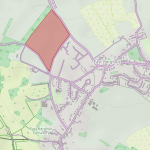The northern part of Hadleigh Road runs between Hughes Road and the A1070 Heath Road.
On the eastern side, set well back is a line of several bungalows leading to a cluster of 2-storey houses from the 1970’s and ‘80’s in Collingwood Fields. This eastern side is not under consideration for the Conservation Area. It is the large field opposite on the western side which needs some protection.
The agricultural area under consideration runs from the tree-and-hedge-lined edge of Hadleigh Road up to the dense linear block of woodland running from a bend in the A1070 to The Lodge entrance on Hughes Road, and south, but parallel to the A12.
Sensitive area archaeologically. At the northern tip of the parish, the site is focussed on the A12 where it follows the line of the ancient Roman road from Colchester to Baylham. Discoveries on both sides of the modern road include Roman pottery, coins, metal objects and brick fragments. These, together with the remains of timber buildings, indicate the presence of one or more Roman settlements.


